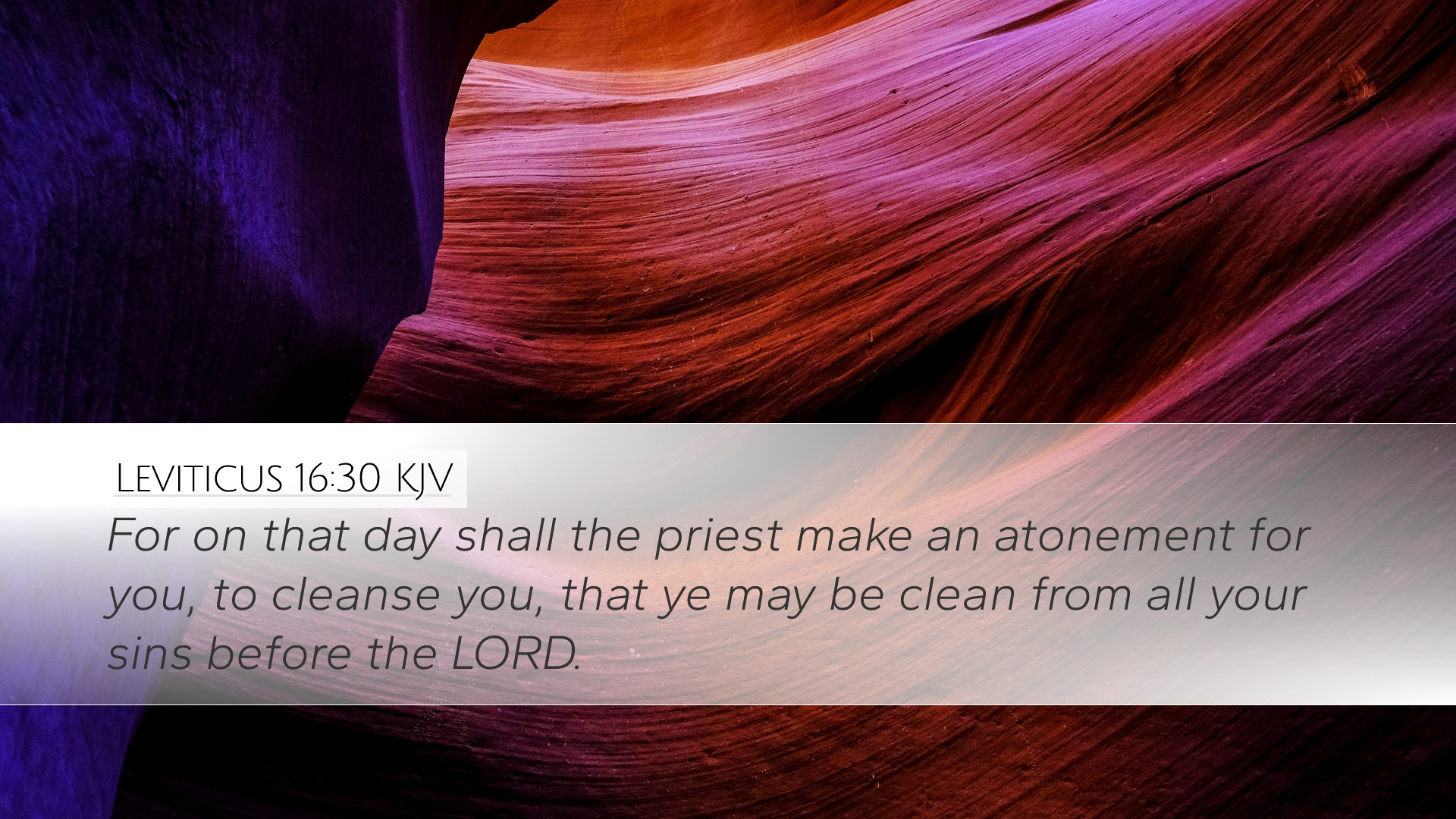Commentary on Leviticus 16:30
Leviticus 16:30 states: "For on that day the priest shall make atonement for you to cleanse you. From all your sins you shall be clean before the Lord." This verse encapsulates the pivotal theme of atonement in the sacrificial system of the Old Testament. It provides a theological foundation that reverberates throughout Scripture, particularly foreshadowing the ultimate atonement accomplished by Christ.
Contextual Background
The Day of Atonement, Yom Kippur, as detailed in Leviticus 16, was a solemn day in the Israelite calendar, highlighting the seriousness of sin and the need for divine cleansing. It was a day dedicated to humbling oneself and offering sacrifices for the collective sins of the community. This verse serves as a culmination of the rituals performed on this day.
Theological Insights
This verse carries immense theological weight, and its implications extend into the New Testament.
- Atonement: The term "atonement" signifies the covering of sin. Matthew Henry emphasizes the necessity of having this spiritual condition rectified, highlighting that both individual and corporate sin necessitate divine intervention.
- Purification: The process of being cleansed before the Lord is a crucial aspect of the Israelite faith. Albert Barnes notes that the priest’s role was not only mediatorial but also transformative, pointing to God's holiness and the intrinsic need for purity among His people.
- Divine Mercy: The act performed on behalf of the people underscores God's mercy. Adam Clarke remarks on God’s willingness to forgive and restore, which reveals character traits of compassion and justice. The atonement ritual foreshadows the greater sacrifice made by Christ on the cross.
- Covenant Relationship: The significance of the Israelite relationship with God hinges upon the acknowledgment of sin and the requirement for atonement. Leviticus 16:30 illustrates how this ritual promotes communal identity and a corporate sense of accountability before God.
Ritualistic Details and Their Symbolism
The ritual on the Day of Atonement was marked by specific actions and symbolism:
- The Scapegoat: The ceremony involved a scapegoat, which was sent into the wilderness, symbolically bearing the sins of the people away. Matthew Henry provides insight into this as a vivid reminder of God's commitment to removing sin from His people.
- High Priest's Role: Only the high priest could enter the Most Holy Place, a metaphor for Christ's unique and supreme priesthood. This ritual, discussed by Clarke, points to Christ who as the High Priest offers Himself as the ultimate atoning sacrifice.
- Blood of Sacrifice: The blood sprinkled in the Holy of Holies symbolizes life and its necessary connection to atonement. Barnes highlights that life must be given for life in reconciliation, indicating the grave cost of sin and the depth of God’s provision.
Applications for Today's Believers
Understanding Leviticus 16:30 has profound implications for contemporary Christians:
- Recognition of Sin: Believers today are called to acknowledge their own sins regularly, reflecting the understanding that sin disrupts relationship with God.
- Understanding Atonement: The ultimate atonement provided through Jesus connects believers to the historical context of sin and redemption, emphasizing its necessity in Christian doctrine.
- Encouragement in God’s Mercy: Just as the Israelites were assured of cleansing, Christians can trust in God’s grace and mercy through faith in Christ.
- Community Accountability: The communal aspect of atonement should encourage unity and prayerful support within congregations, fostering collective responsibility towards sin and righteousness.
Conclusion
Leviticus 16:30 encapsulates a profound theological truth about God's desire for His people to be cleansed and restored. The insights drawn from public domain commentaries illuminate the rich tapestry of meaning woven throughout this verse. Both the historical rituals and their New Testament fulfillment in Christ remind us of the gravity of sin and the immensity of God's redemptive love.


